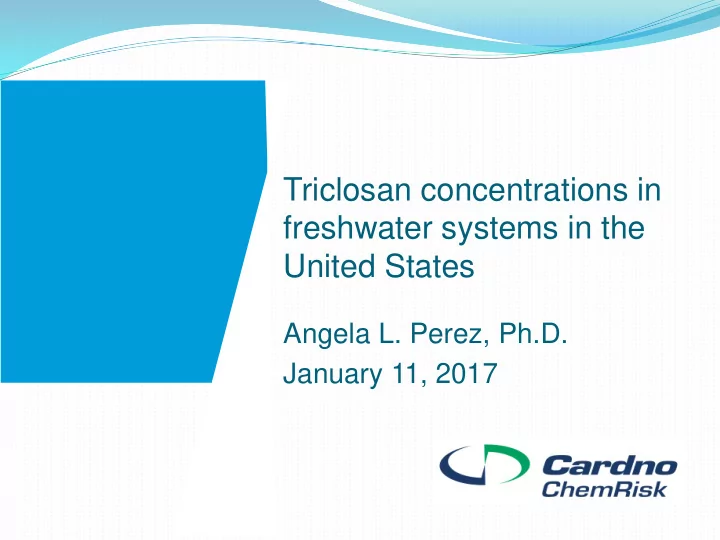

Triclosan concentrations in freshwater systems in the United States Angela L. Perez, Ph.D. January 11, 2017
Purpose of our study Characterize TCS in freshwater aquatic systems and untreated and treated source waters supplying municipal drinking systems in the US, 1999-2012 Compare measured values to health and aquatic guidance values 1/11/2017 2
Objectives Create database of freshwater TCS concentrations Literature search 1999-2012 “triclosan”, “triclosan AND water”, and “antimicrobial AND water” Peer-reviewed studies, gray literature, municipality reports Raw data and summary statistics 500 papers identified 46 fit data quality objectives 45 states and 1 US territory 1/11/2017 3
Water Classification 1. Untreated water Effluent 2. Effluent-impacted environmental 3. 4. Environmental waters Post-treatment drinking water 5. 1/11/2017 4
Statistical Analysis Regression on order statistics (ROS) Extrapolate values from samples below LOD or censored data ANOVA on water categories Dunn’s all-pairwise for significant differences Kaplan Meier to calculate upper confidence limit 1/11/2017 5
Triclosan Meta-data 46 studies included; raw data from 44 studies N =242 Untreated N =453 93% N=192 1% Effluent 83% N=228 Effluent-Impacted 62% Environmental Environmental N=1195 11% Finished % = detection frequency 1/11/2017 6
Triclosan Meta-data Effluent- Impacted ng/L Untreated Effluent Environmental Environmental Finished N 237 192 228 1195 453 mean (imputed) 9715 775 130 13 4 maximum* 393000 8000 2300 2830 734 *Based on raw data 1/11/2017 7
Sources of Variability Lack of information on sampling locations Challenges classifying water categories (e.g. effluent-impacted classified as environmental) Spill events TCS input: Rural vs. urban, heavy vs. light industry Wastewater treatment processes vary across locations Biological and chemical transformations Half life between 2 days and 2000 days Stream pH affects solubility/adsorption Stream flow, seasonal effects 1/11/2017 8
Risk Characterization - Human Health EPA chronic RfD = 0.3 mg/kg bw/day = 1.05 x 10 7 ng/L (70 kg human and 2 L drinking water per day) Max TCS concentration in finished water = 734 ng/L EPA Chronic RfD TCS in drinking water does not pose a significant human health risk 1/11/2017 9
Risk Characterization - Ecological Wilson et al. Orvos et al. Algae most sensitive species 15 ng/L Chronic LOEC (Wilson et al., 2003) In exceedance: 82% effluent-impacted waters 11% environmental waters 500 ng/L Chronic NOEC (Orvos et al., 2002) In exceedance: 5.3% effluent-impacted waters 0.25 % environmental waters 376 ng/L Health Canada PNEC 1/11/2017 10
Reflections Strengths Sample size Geographically comprehensive Careful analysis of each paper Weaknesses Categories not well defined (effluent-impacted vs. effluent or environmental) Sources of variability not accounted for (e.g. stream sizes) 1/11/2017 11
Conclusions In over 2300 samples, TCS is widely detected Low human health risk as a result of triclosan exposures via drinking water Effluent-exposed freshwaters may exceed threshold indicators for ecological health, esp. algae Contact: angela.perez@cardno.com 1/11/2017 12
Research Questions Are TCS concentrations or detections in aquatic systems decreasing over time? Does the recent FDA ban on TCS in hand-soap result in a change in TCS concentrations detected in aquatic systems? Contact: angela.perez@cardno.com 1/11/2017 13
1/11/2017 14
Recommend
More recommend